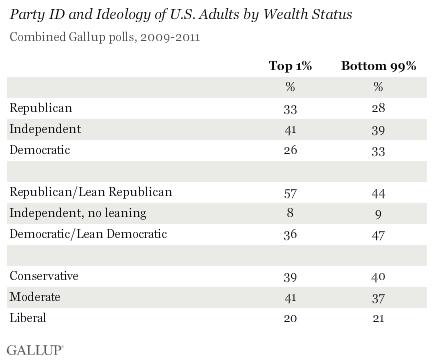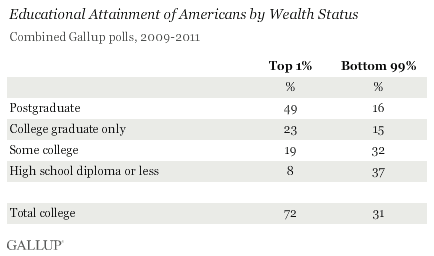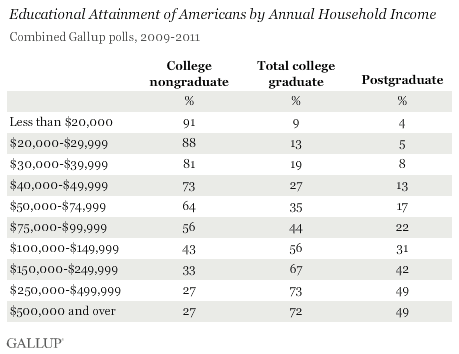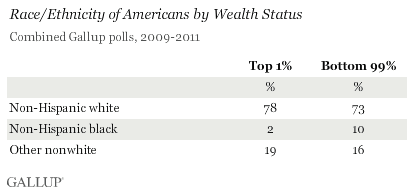PRINCETON, NJ -- Politically, the wealthiest 1% of Americans -- those in households earning $500,000 or more annually -- are somewhat to the right of the remaining 99%, but more in terms of party identification than self-professed ideology. One-third of the nation's "1%" identify themselves as Republicans, 41% as independents, and 26% as Democrats. This is a mirror image of the "99%," a third of whom are Democrats, with 39% independents and a quarter Republicans.

When the party leanings of independents are taken into account, 57% of the nation's wealthiest adults associate themselves with the Republican Party, compared with 44% of the "99%." At the same time, Gallup polling finds little difference in the two groups' ideological views. Among the very wealthy, 39% say their political views are conservative, 41% call themselves moderate, and 20% liberal, similar to the percentages seen among all others.
The Occupy Wall Street movement has made the contrast between the economic circumstances of the nation's wealthiest 1% and the remaining 99% the focus of its criticism of the nation's economic system, and particularly of the financial services sector.
To better understand who makes up the top 1%, Gallup combined 61 of its nationwide surveys conducted between January 2009 and November 2011. The resulting sample includes nearly 400 adults in households earning $500,000 or more annually, and more than 65,000 in households earning less than that. The official top 1% of American households in 2010 includes those with incomes of at least $516,633, according to data from the Tax Policy Center as reported in The Washington Post.
Advanced Education Separates the 1% From the 99%
Apart from their bank accounts, Gallup finds education to be the greatest difference between the wealthiest 1% of Americans and everyone else. The Gallup analysis reveals that 72% of the wealthiest Americans have a college degree, compared with 31% of those in the lower 99 percentiles. Furthermore, nearly half of those in the wealthiest group have postgraduate education, versus 16% of all others.

More generally, college education is strongly correlated with household income. Nine percent of Americans earning less than $20,000 per year are college graduates; this rises to majorities of adults in all income groups above $100,000. Similarly, few adults in low-income households have postgraduate education, and this rises only into the teens among middle-income adults. But it sharply increases among those earning $100,000 or more, peaking at 49% among those earning between $250,000 and $499,000, and those earning at least half a million.

The educational differences between the nation's "1%" and "99%" exceed all other demographic as well as political differences seen between these groups in the Gallup data. The next-most-significant distinction is marital status, with nearly three-quarters of the very wealthy (73%) being currently married, compared with half of all others (51%). Accordingly, by 49% to 31%, the very wealthy are more likely to have minor children in the household.
While all major racial/ethnic groups are represented in the wealthiest 1%, the group is more likely to be white and less likely to be black than the bottom 99%.

It should be noted that the results do not describe the characteristics of the primary wage earner in each household, because Gallup randomly selects one adult to be interviewed from all adults living in each household. Rather, the results reflect the demographic and political characteristics of all U.S. adults living in the wealthiest 1% of households.
Super Wealthy More Likely to Be Found on the Coasts
Higher proportions of the "1%" than of the "99%" live in the East and West, while the "1%" is particularly less likely to live in the Midwest.

Bottom Line
The nation's wealthiest Americans are now the focal point of a political debate that is filtering into the 2012 presidential campaign, and could have significant implications for how much of their income they will keep under future tax codes. Over the three-year span of President Barack Obama's presidency to date, the wealthiest 1% of Americans have been somewhat more Republican or Republican-leaning than all other Americans in their political orientation.
However, the 13-percentage-point gap seen between the two groups on this basis falls far short of the gaps between them in higher education. In particular, the 33-point gap in the percentages with postgraduate education, 49% vs. 16%, highlights the importance of advanced education as a prerequisite for financial success. In fact, the relative prevalence of postgraduate education could be even greater when one looks at primary wage earners, as opposed to all adults, in the top 1%.
This is not to say that college degrees guarantee vast wealth. To the contrary, only a small fraction of all Americans who report having a postgraduate education (1.5%) or an undergraduate degree but no postgraduate education (0.8%) fall into the top 1% category. However, the comparable rates are many times smaller -- no greater than 0.3% -- at all other educational levels. Perhaps as the nation's leaders review the equity of the nation's tax code, they should also consider ways to encourage more Americans to obtain the higher levels of education that could help them gain greater financial security, if not great wealth.
Survey Methods
Results are based on an aggregate of 61 nationally representative Gallup surveys conducted between January 2009 and November 2011. This encompasses telephone interviews with a random sample of 65,662 national adults, aged 18 and older.
For results based on the total sample of 397 adults in households earning $500,000 or more annually, one can say with 95% confidence that the maximum margin of sampling error is ±6 percentage points.
For results based on the total sample of 65,265 adults in households earning less than $500,000 annually, one can say with 95% confidence that the maximum margin of sampling error is less than ±1 percentage point.
Interviews are conducted with respondents on landline telephones and cellular phones. Cell phones numbers are selected using random digit dial methods. Landline respondents are chosen at random within each household on the basis of which member had the most recent birthday.
In addition to sampling error, question wording and practical difficulties in conducting surveys can introduce error or bias into the findings of public opinion polls.
For more details on Gallup's polling methodology, visit www.gallup.com.
